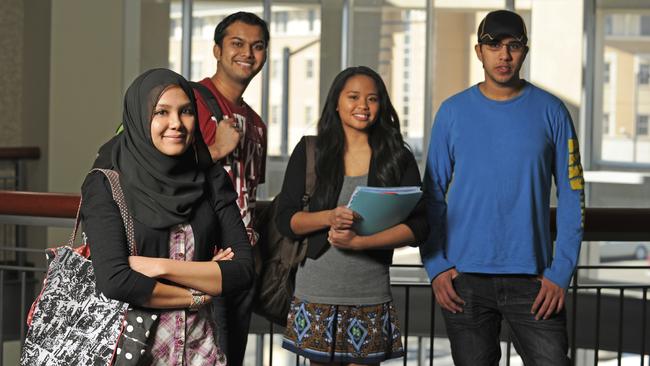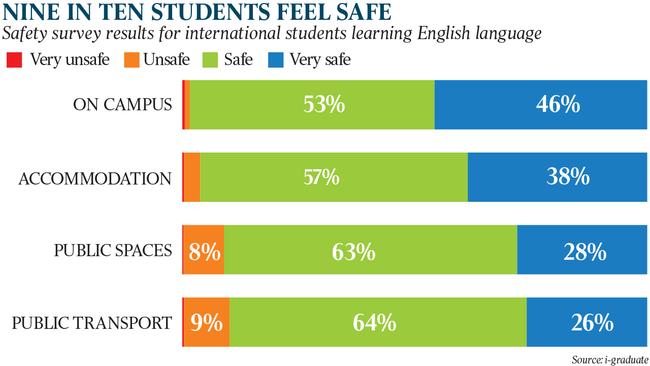Foreign students satisfied with our English teaching, but watch out for Canada
The latest survey of English language students is good but more work is needed.

After seven consecutive months of decreases in commencements, the release of April Department of Education and Training international student enrolment data shows Australia’s English language teaching sector has rebounded slightly.
Although this improvement has been driven largely by our biggest market, China, sector data shows continuing volatility, and globally the competition for English language students is as intense as it has ever been.
It is timely, then, that results from Australia’s largest English language student satisfaction survey are being released, to provide insights into what we are doing well and what we can improve.
Now in its fifth iteration, the English Language Barometer survey, run every two years for English Australia by i-graduate and sponsored by the DET, canvassed the opinions of more than 15,000 English language students studying in Australia.
Broadly the results are positive, but there is more to be done.
The survey is offered in 11 languages, and 60 English language centres across the country participated. With 15,662 student respondents, this was the largest survey of English language students conducted in Australia. Half of the respondents were enrolled in programs to improve their English in preparation for further studies, while one third were studying general English.
China accounted for half of the respondents, underlining the importance of that market, followed by Japan (9 per cent), Colombia (5 per cent), Brazil (5 per cent) and South Korea (4 per cent).
Ninety per cent of respondents were satisfied or very satisfied with their overall experience in Australia, up from 89 per cent in 2016 and 81 per cent in 2009, the first year the survey was run.

Teaching quality and personal safety were the top two factors considered by students when deciding where to study overseas. Student recruitment agents exerted the most influence over students: 70 per cent of respondents cited agents as a key influence, ahead of family (25 per cent) and alumni (22 per cent). In positive news for the sector, 92 per cent of respondents were satisfied or very satisfied with services provided by those recruitment agents, up from 91 per cent in 2016 and 82 per cent in 2009.
Traditionally Australia’s biggest rivals for international students have been the US and Britain, followed by Canada and New Zealand. The survey asked respondents which other countries they had applied to in addition to Australia.
Applications to the US, Britain and New Zealand were down compared with survey results from 2016, but Canada is on the rise. Twenty-six per cent of respondents had applied to Canada as well as Australia, up from 24 per cent two years ago. As with anecdotal evidence in other sectors, Canada is a growing force in international education.
Interestingly, more than one-quarter of students in Australian language centres (27 per cent) did not apply to any other country, well up on 2016 (22 per cent). Satisfaction with living costs in Australia was low at 64 per cent, but better than 2009 (52 per cent) and 2011 (49 per cent) when our dollar was closer to parity with the US dollar. Costs of study and living are factors for 92 per cent of students, so exchange rate movements do have an impact.
For 97 per cent of students, personal safety was a key decision factor in deciding where to study overseas. Importantly, satisfaction levels with safety for English language students were particularly high, with 90 per cent rating public transport as safe or very safe, and 99 per cent rating their campuses as safe or very safe.
The ELB survey interrogates about 100 elements of the student experience, from arrival to learning and living experiences, and satisfaction with support services.
I-graduate correlates satisfaction scores with students’ propensity to recommend their institution to others, to try to understand which aspects of the student experience most affect word-of-mouth recommendations.
In this year’s results, course content correlated most highly with propensity to recommend — in other words, what students learn in the classroom matters. Happily, 91 per cent of respondents indicated they were satisfied or very satisfied with course content — Australia’s English language centres are getting the fundamentals right.
Deeper analysis, however, reveals variation in satisfaction levels among students from different countries. Ninety-four per cent of Chinese students are satisfied or very satisfied with their overall experience in Australia, compared with 85 per cent of Japanese students. This is a significant difference in attitude between students from Australia’s top two English language markets and requires further investigation.
English Australia is using the results of the 2018 survey to develop a best practice guide featuring case studies of English language colleges to inform quality improvements in the sector.
This year DET also is supporting surveys of international students in high schools, TAFE colleges, universities, private providers and at locations offshore where international students are studying Australian programs in their home countries. More than 400 education institutions will participate in the surveys, with responses from more than 90,000 international students. Their views will provide important information about how well Australia is able to attract, teach and support international students in a highly competitive global market.
Brett Blacker is chief executive of English Australia. Stephen Connelly is director of i-graduate Australia.



To join the conversation, please log in. Don't have an account? Register
Join the conversation, you are commenting as Logout